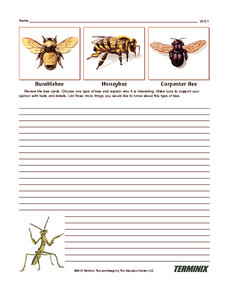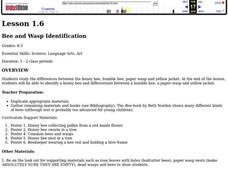Core Knowledge Foundation
Plants Tell It Again!™ Read-Aloud Anthology
A 190-page anthology explores the life and parts of plants, flowers, and trees while boosting reading comprehension skills. Literature and informational texts showcase Johnny Appleseed and George Washington Carver. Lessons...
Curated OER
Darwin’s Bees
What do you call a bee born in May? A maybe! This first instructional activity in a series of four begins with a starter activity to get scholars thinking about the topic. Then a circus, or circuit of seven activities,...
PBS
Reading Adventure Pack: Bees
A Reading Adventure pack explores the busy life of bees. After reading a fiction and nonfiction text, scholars complete three hands-on activities. Participants invent a robot that can do the work of bees, cheers to hardworking bees with...
Smithsonian Institution
Expedition: Insects
Get up close and personal with beautiful and sometimes dangerous insects in an exciting eBook activity! Pupils practice geography skills by reading a map with the location of six different insects. Scientists read about each insect,...
College Board
2011 AP® Environmental Science Free-Response Questions
Beetle population, climate change, and acidification are all real environmental threats. Scholars display their knowledge of these threats and offer solution strategies in a four-question assessment resource. Questions from the AP® exam...
Curated OER
The Buzz About Honey
What's the buzz these days? Learn some fun and interesting facts about honeybees with an informational reading passage, including the steps for successful pollination and honey creation.
The New York Times
Trouble in the Hive: Researching the Decimation of Honeybee Colonies
Teach your class about colony collapse disorder and foster discussion about causes and solutions for the honeybee problem. Class members read and discuss an article and participate in one of two detailed activities about pollination and...
Curated OER
Alternative Animal Agriculture
Presenting an unusual topic, this collection of slides examines alternative animals that can be grown for profit or human use. It details the raising of rabbits as food, llamas for textiles, earthworms as fish bait, and a variety of...
K5 Learning
The Bee
Early readers follow along as Lucy and her mother discuss why a bee is stuck in a flower then answer four reading comprehension questions.
Terminix
Bee Writing Prompt
What do your pupils know about bees? Ask them to examine facts and images about three different types of bees and write about one type. Pupils explain why their chosen bee is interesting and back up their ideas with facts and opinions....
Curated OER
I Wonder What a Pest Is...
Students observe what animals are considered to be pests and why. They conduct a mock trial of a honeybee arguing if it is a pest or not. They determine pros and cons of honeybees to prepare for the trial.
Curated OER
The Sweet Connection
Students use maps to find what crops are dominant in areas where honey bees are raised and discuss possible correlations. They mark the top ten honey- producing states on a US map.
Curated OER
Buzzing Bee's Wardrobe
Students investigate the anatomy of honeybees. In this anatomy lesson, students research the physical characteristics of bees and discover what they do. Students create a model of a honeybee showing the correct anatomy.
Curated OER
"The Buzz About Honeybees"
In this reading comprehension worksheet, students read an article on, "The Buzz About Honeybees", and then answer 10 short answer reading comprehension questions.
Curated OER
The Disappearing Honeybees: Tracking Honeybee Decline
Students practice graphing and other math skills to track number of honeybee colonies present in United States since 1978, discuss major crops that are dependent on insect pollinators, and examine reasons for decline of United States...
Curated OER
Bees and Honey
Students are challenged to build a bee home out of provided materials and discover a way to produce a new flavor of honey. Students research beekeeping and honey production and brainstorm possible ideas for bee homes and honey production...
Curated OER
The Honey Bee Body
Students construct a paper honey bee to learn the six major parts of a bee and other insects. They compare their own body parts to those of bees. They utilize activity sheets that are imbedded in this plan.
Curated OER
The Honeybee Life Cycle
In this the honeybee life cycle worksheet, 3rd graders study the diagram of 6 stages in a honeybee's life, then fill in 3 short answer questions.
Curated OER
Honey bee sentences
In this honey bees worksheet, students read sentences about honey bees and rewrite and correct the sentences. Students rewrite 4 sentences.
Curated OER
The Honey Bee's Home
Students study honey bees by researching handouts and books. In this honey bee lesson plan, students make a comb out of polygons, learn about the 4 stages of insect development, and view how the hive hierarchy works.
Curated OER
Bee and Wasp Identification
Young scholars study the differences between honey bee, bumble bee, paper wasp, and yellow jackets. In this insect classification lesson, students study posters of various bees and wasps. Young scholars read the story Holly Honey Bee...
Curated OER
What Bees Eat
Students study plant and animal interdependence by studying bees and pollination. In this interdependence lesson, students discuss flower parts and dissect it to show its reproductive parts. Students then use tissue and pipe cleaners to...
Curated OER
Honey Bee Communication
Students participate in a role play to show how honey bees communicate with one another. In this honey bee instructional activity, students learn that honey bees communicate with dance. Students create the honey bee...
Curated OER
Why Are Bees Important?
Students identify and analyze pollination and how bees play an important part in the life cycle of flowering plants. They also identify the process of plant pollination and how bees play an important part in the life cycle of flowering...

























